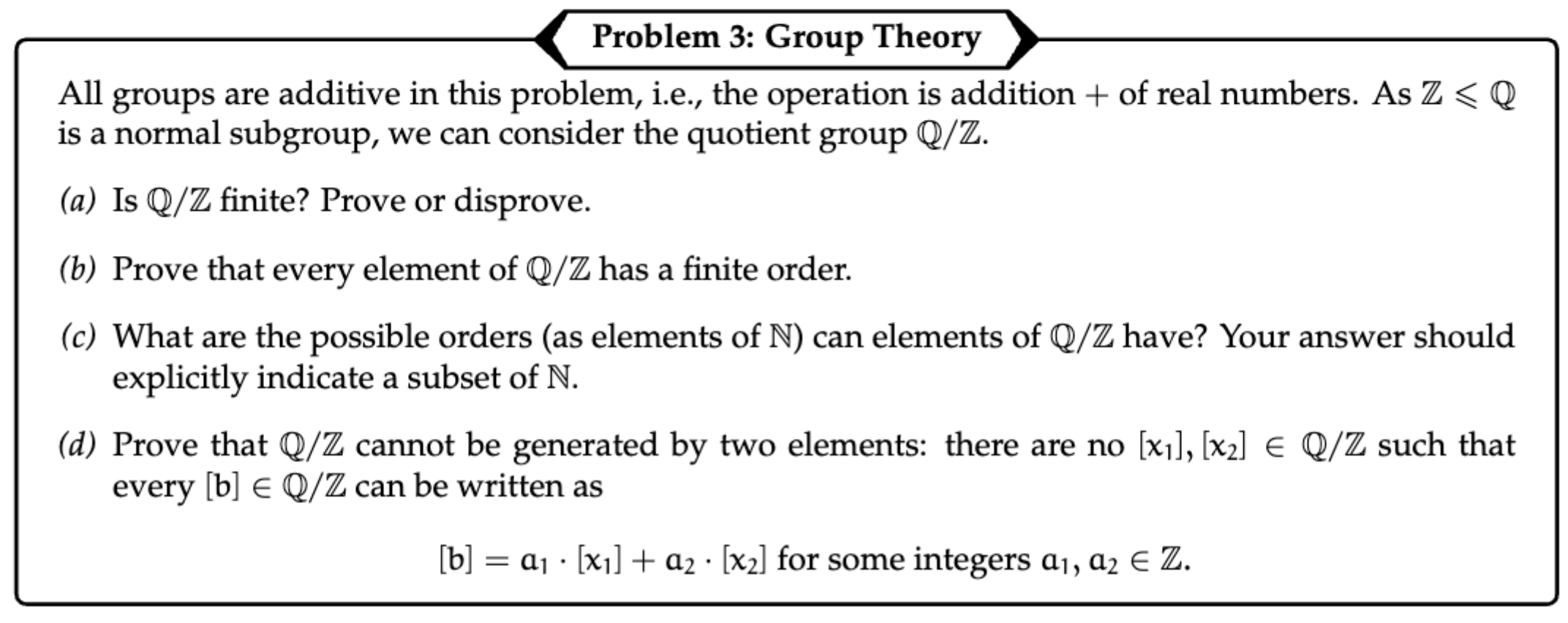Question 0
Top

a:
A Ideal in a commutative ring with identity is a subring where for all in the ideal.
b.
A group action on this map can be defined as for all and .
Bottom

a.
A in for some is .
b.
For the division algo can be formulated as the following:
For any there exists and where
And is less then or is zero. Note the norm function here is
For the division algo can be formulated as the following:
For any there exists and where
And the degree of is less then or is zero.
Question 1
Top

a.
and . This will be proved again later.
b.
Proof:
- Lets first prove .
- This is easy as we have additive closure, so if both are in we have it so and this direction is proved.
-
- We have to prove that
- Notice, .
- and similarly
- From here, we know
- So, and .
Bottom

a.
b.
The norm of is defined as . This exists in the natural numbers, and notice that or can never be negative. Thus all norms less then 5 have to be able to be written as a square of integers . Both and this norm is not possible.
Question 2
Top

a.
Proof:
- Let . and . We have to show .
- First, lets see where is. Notice that if then we would have which is a contradiction. So .
- This is good because we know that and all its powers are also in . Thus and we have proved that we can generate every element of with .
b.
Proof:
- For the sake of contradiction, assume that was an injective homomorphism.
- Then, let . As the homomorphism is injective, is the case only
- Then, we know .
- As all the , only such is zero, meaning 1 is also in the kernel thus this is not injective.
Problem 2
Top

a.
b.
The largest possible order in is the highest possible LCM with integers that add up to 8 This is and are the elements that are the products of disjoin 3 and 5 cycles.
Problem 3
Top

a
g is power 4 as it gets the identity when multiplied to itself 4 times.
h is power 3
You can not use the LCM rule for the order here because that only works if the elemets commute. The order is infinate if you multiply it out
b
Proof:
- The only subgroups of are trivial via langranges. So can either be iso to {e} or . will always have elements, so the only case is that it is iso to which only happens when is .
Bottom

a
Problem 4
Top

a
Lets define where . The kernel of this is exactly as all these will go to zero when evaluated at 2, thus by first isomorphism theorem
Lets define where . The kernel of this is exactly as all these will go to zero when evaluated at , thus by first isomorphism theorem
Evaluation homomorphisms are surjective as the integers alone get every single real number
Bottom

b.
Notice that the ideal contains elements Then, you can get every element in with integer multiples of 7. Now notice, this leaves all integers such that This leaves mod or more precisely has elements This is just the ring which is a field as is prime. Thus we have it so is maximal.
Problem 6

c.
We know that .
Letting we know that as the minimal polynomial is
Now assume for some . then and then as C is already in K we simply get which is a contradiction.

a.
We know as the minimal polynomial in is .
By tower rule, another supposed subfield between and would have to divide 2 in the natural numbers. However this is not possible as 2 is prime thus the only possible subfields are and .